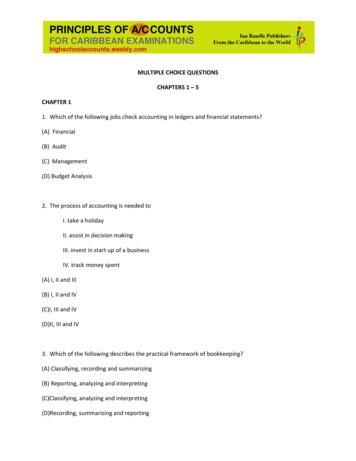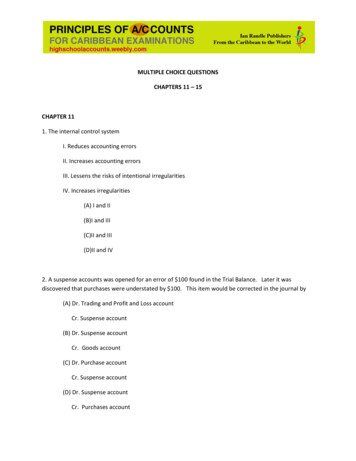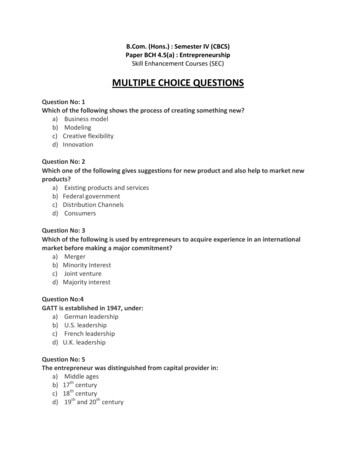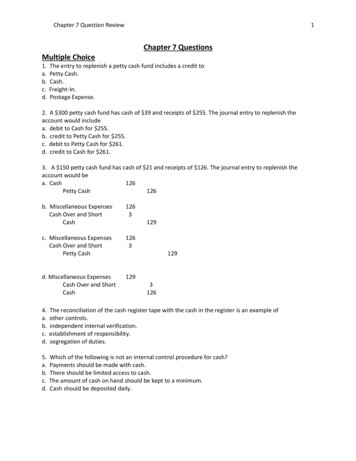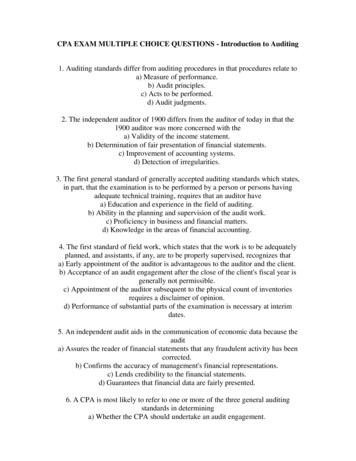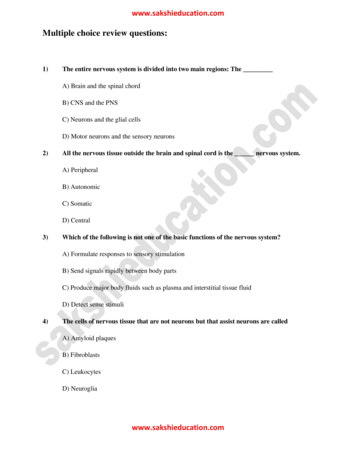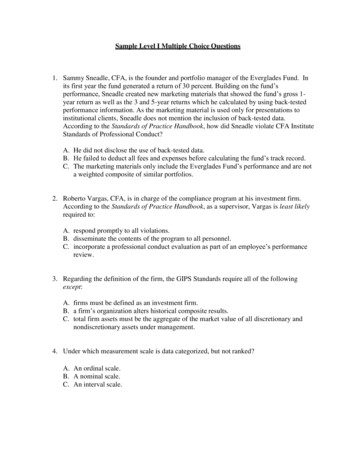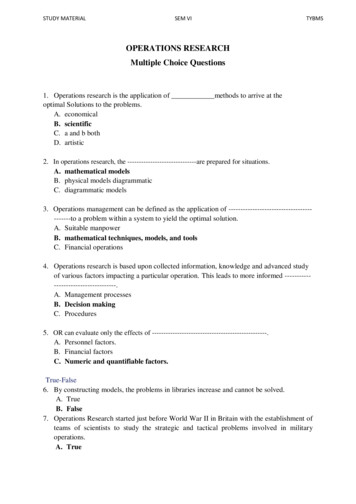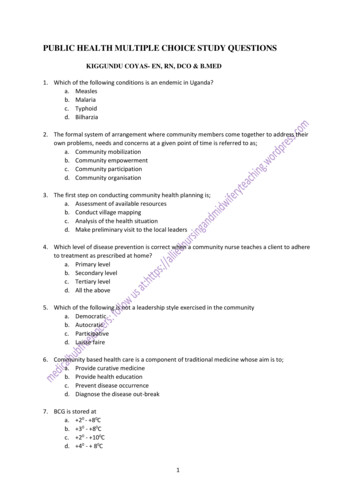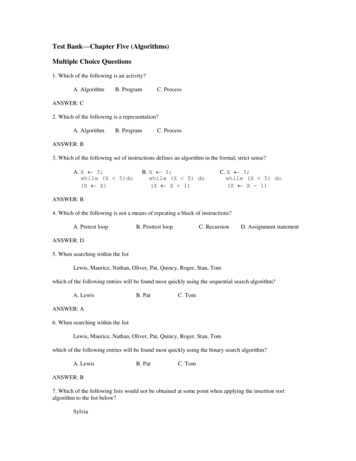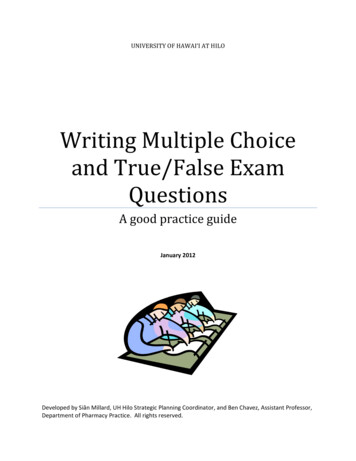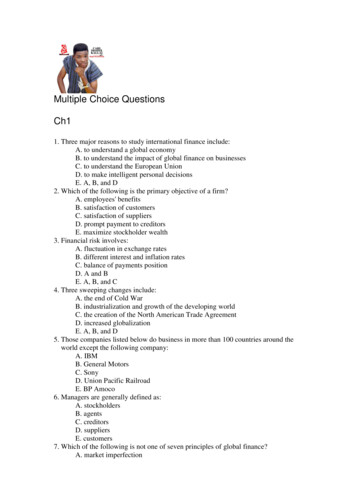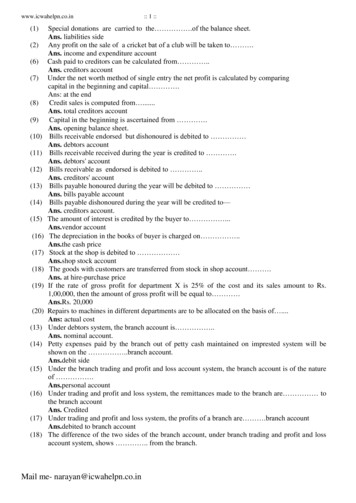
Transcription
)(18):: 1 ::Special donations are carried to the .of the balance sheet.Ans. liabilities sideAny profit on the sale of a cricket bat of a club will be taken to .Ans. income and expenditure accountCash paid to creditors can be calculated from .Ans. creditors accountUnder the net worth method of single entry the net profit is calculated by comparingcapital in the beginning and capital .Ans: at the endCredit sales is computed from .Ans. total creditors accountCapital in the beginning is ascertained from .Ans. opening balance sheet.Bills receivable endorsed but dishonoured is debited to Ans. debtors accountBills receivable received during the year is credited to .Ans. debtors' accountBills receivable as endorsed is debited to .Ans. creditors' accountBills payable honoured during the year will be debited to Ans. bills payable accountBills payable dishonoured during the year will be credited to—Ans. creditors account.The amount of interest is credited by the buyer to .Ans.vendor accountThe depreciation in the books of buyer is charged on .Ans.the cash priceStock at the shop is debited to Ans.shop stock accountThe goods with customers are transferred from stock in shop account .Ans. at hire-purchase priceIf the rate of gross profit for department X is 25% of the cost and its sales amount to Rs.1,00,000, then the amount of gross profit will be equal to Ans.Rs. 20,000Repairs to machines in different departments are to be allocated on the basis of .Ans: actual costUnder debtors system, the branch account is .Ans. nominal account.Petty expenses paid by the branch out of petty cash maintained on imprested system will beshown on the .branch account.Ans.debit sideUnder the branch trading and profit and loss account system, the branch account is of the natureof .Ans.personal accountUnder trading and profit and loss system, the remittances made to the branch are tothe branch accountAns. CreditedUnder trading and profit and loss system, the profits of a branch are .branch accountAns.debited to branch accountThe difference of the two sides of the branch account, under branch trading and profit and lossaccount system, shows . from the branch.Mail me- narayan@icwahelpn.co.in
www.icwahelpn.co.in:: 2 ::Ans.amount due(19) Branch adjustment account is in the nature of .Ans.nominal account(20) If the branch has collected money from a customer of the head office, then (in the head officebooks) branch account is .Ans.debited(21) In case of foreign branches, the remittances to and from head office should be convertedat Ans.actual rate at which the remittances were made.(22) Cash remitted by branch but not received by the head office is debited by the head officeto Ans.cash-in-transit account.(23) Goods sent by the head office to the branch not received by the branch are credited by H.O.to Ans.branch account(24) Goods sent by branch x to branch y, will be debited to Ans.branch y(25) Closing stock cost of goods sold—Purchases Ans.opening stock(26) The main object of the average clause is to discourage .Ans.under insurance(27) Under the average clause, the loss is suffered by both insurer and insured a.Ans.in the ratio of risk covered(28) Royalty account is in the nature of .a.Ans.nminal account(28) If the right to recoup the shortcomings has expired, they are transferred by thelesseeto Ans.Profit and loss account(29) The receipts and payments account records receipts and payments of both apitaland .nature.Ans.revenue(30) Income and Expenditure accunt is a Ans. nominal account(31) The income and expenditure account begins with .Ans. no balance(16)(17)(18)When the lessor receives payment, the credits—(i) Lessee account(ii) Royalty account(iii) Short workings account.Ans.(i) Lessee accountRoyalty earned by the lessee is credited to—(i) Sub-lessee account(ii) Profit and loss account(iii) Royalty receivable account.Ans.(iii) Royalty receivable account.The balance of royalty payable account is transferred to—(i) Profit and loss account(ii) Royalties suspense account(iii) Production account.Ans.(iii) Production account.Mail me- narayan@icwahelpn.co.in
)(27)(28):: 3 ::The balance of royalty‟s receivable account is transferred to —(i) Profit and loss account(ii) Royalties suspense account(iii) Production account.Ans.(i) Profit and loss accountUnder the double account system, the profit and loss account is called—1. Profit and loss account2. Income and expenditure account3. Revenue account.Ans.(iii) Revenue account.Under the double account system, the profit and loss appropriation account is called —(i) Net revenue account(ii) Profit and loss appropriation account(iii) Profit and loss account.Ans. (i) Net revenue accountThe depreciation on the fixed assets, under the double account system, is shown as—4. Depreciation reserve on the liabilities side of the general balance sheet5. A deduction from the fixed assets6. An expenditure on capital account in the first section of the balance sheet.Ans. (i) Depreciation reserve on the liabilities side of the general balance sheetUnder the double account system, interest on debentures is shown in—(i)Revenue account(ii) Net revenue account(iii) Profit and loss account.Ans.(ii) Net revenue accountShare forfeited account is shown on—7. Liabilities side of the general balance sheet8. Credit side of the net revenue account9. Credit side of the receipts and expenditures on capital accountAns.(iii) Credit side of the receipts and expenditures on capital accountA fixed asset originally acquired for Rs. 20,000 is to be replaced by new one. The estimatedcost of replacement of the original asset is Rs. 30,000. Hence, the revenue charge equals —(i) Rs. 20,000(ii) Rs. 10,000(iii)Rs. 30,000.Ans. (iii) Rs. 30,000.A fixed asset originally acquired for Rs. 20,000 is replaced by a new asset costing Rs. 50,000.But the estimated cost of replacement of the original asset is B Rs. 30,000. Hence, the capitalcharge equals—10. Rs. 20,00011. Rs. 50,00012. Rs. 30,000.Ans.(i) Rs. 20,000A fixed asset originally acquired for Rs. 20,000 is replaced by a new asset. The estimated costof the replacement of the original asset is Rs. 30,000. The sale proceeds of old materialamounted to Rs. 2,000.Hence, the revenue charge equals(i) Rs. 28,000(ii) Rs. 18,000(iii) Rs. 30,000.Ans.(i) Rs. 28,000Calls in advance are shown on the—13. Liabilities side of the general balance sheetMail me- narayan@icwahelpn.co.in
www.icwahelpn.co.in(29):: 4 ::14. Expenditure side of receipts and expenditures on capital account15. Receipts side of receipts and expenditures on capital account.Ans.(iii) Receipts side of receipts and expenditures on capital account.Plant and machinery is shown on the—(i) Assets side of the general balance sheet(ii) Expenditure side of the receipts and expenditures on capital account(iii) Receipts side of the receipts and expenditures on capital account.Ans.(ii) Expenditure side of the receipts and expenditures on capital accountMail me- narayan@icwahelpn.co.in
)(38):: 5 ::The value of goodwill, according to the simple profit method, is—16. The product of current year's profit and number of years17. The product of last year's profit and number of years18. The product of average profits of the given years and number of years.Ans.(iii)The product of average profits of the given years and number of years.The goodwill of a business is to be valued at 3 years' purchase of the average profits of the lastthree years. The profits of the last three years are Rs. 5,000, Rs. 6,000 and Rs. 7,000respectively. Hence, the goodwill be valued at—(i) Rs. 18,000(ii) Rs. 12,000(iii) Rs. 15,000.Ans. (i) Rs. 18,000A business has a capital of Rs. 40,000 at the end. It had earned profits of Rs. 5,000 during theyear. Hence, the average capital of the business will be —(i) Rs. 42,500(ii) Rs. 37,500(iii) Rs. 35,000.Ans.(ii) Rs. 37,500If the average capital of a business is Rs. 60,000 and the normal rate of profit is 15%, then thenormal profits will amount to—(i) Rs. 10,000(ii) Rs. 9,000(iii) Rs. 15,000.Ans.(ii) Rs. 9,000If the super-profits of a business are Rs. 6,000 and the normal rate of profit is 10%, then theamount ofgoodwill as per the capitalisation method will be—(i)Rs. 60,000(ii) Rs. 600(iii) Neither of the two.Ans.(i)Rs. 60,000It is given that net assets available for equity and preference shares amount to Rs. 90,000. Thepaid up capitals are 10,000 equity shares of Rs. 2 each and 5,000 preference shares of Rs. 10each. Therefore, value of an equity share will be—(i) Rs. 2 per share(ii) Rs. 4 per share(iii) Rs. 5 per share.Ans.(ii) Rs. 4 per shareIt is given that net assets available for equity and preference shares amount toRs.1,87,000. The paid-up capitals are—10,000 equity shares of Rs. 4 each and 5,000 preferenceshares of Rs. 10 each. Therefore, value of a preference share will be— (i) Rs. 10 per share(ii) Rs. 8 per share(iii) Rs. 20 per share.Ans.(iii) Rs. 20 per share.Under the yield method of valuation of equity share capital, if for an equity share of Rs. 50, thenormal rate ofreturn is 10% and the expected rate of return is 5%, then the value of anequity share will be—19. Rs. 2520. Rs. 5021. Rs. 100.Ans.(i) Rs. 25For calculating the value of an equity share by intrinsic value method, it is essential to know—Mail me- narayan@icwahelpn.co.in
www.icwahelpn.co.in(39)(40)(41)(42)(43)(44)(45):: 6 ::(i) Normal rate of return(ii) Expected rate of return(iii) Net equity.Ans.(iii) Net equity.For calculating the value of an equity share by yield method, it is essential to know—(i)Expected rate of return(ii) Called-up equity share capital(iii) Capital employed.Ans. (i) Expected rate of returnFor calculating price-earnings ratio, it is essential to know—(i) Market value per share(ii) Nominal value per share(iii) Paid-up value per share.Ans.(i) Market value per shareFor calculating the value of an equity share by earning capacity method, it is essential to know—(i)Nominal value per share(ii) Rate of earning(iii) Dividend per share.Ans.(ii) Rate of earningA Ltd. and B Ltd. go into liquidation and a new company X Ltd. is formed. It is a case of—(i) Absorption(ii) External reconstruction(iii) Amalgamation.Ans.(iii) Amalgamation.X Ltd. goes into liquidation and a new company Z Ltd. is formed to take over the business of XLtd. It is a case of—(i) Absorption(ii) External reconstruction(iii) Amalgamation.Ans.(ii) External reconstructionX Ltd. goes into liquidation and an existing company Z Ltd. purchases the business of X Ltd. Itis a case of—(i) Absorption(ii) External reconstruction(iii) Amalgamation.Ans.(i) AbsorptionAccumulated profits include—(i) Provision for doubtful debts(ii) Superannuation fund(iii) Workmen's compensation fund.Ans.(iii) Workmen's compensation fund.Mail me- narayan@icwahelpn.co.in
):: 7 ::Liabilities (not accumulated profits) of a company include—(i) General reserve(ii) Pension fund(iii) Dividend equalisation fund.Ans. (ii) Pension fundWhen the expenses of liquidation are to be borne by the vendor company, then the vendorcompany debits—(i) Realisation account(ii) Bank account(iii) Goodwill account.Ans. (i) Realisation accountWhen the expenses of liquidation are to be borne by the purchasing company, then thepurchasing company debits—(i) Vendor company's account(ii) Bank account(iii) Goodwill account.Ans. (iii) Goodwill account.When the purchasing company makes payment of the purchase consideration, it debits—(i) Business purchase account(ii) Assets account(iii) Vendor company's account.Ans. (iii) Vendor company's account.The vendor company transfers preliminary expenses (at the time of absorption) to—(i) Equity shareholders' account(ii) Realisation account(iii) Purchasing company's account.Ans. (i) Equity shareholders' accountFor paying liabilities not taken over by the purchasing company, the vendor company credits—(i) Realisation account(ii) Bank account(iii) Liabilities account.Ans.(ii) Bank accountIn case of inter-company holdings, the purchasing company, at the time of payment of thepurchase consideration, surrenders the shares in the vendor company by crediting—(i) Vendor company's account(ii) Shares in the vendor company account(iii) Share capital account.Ans.(ii) Shares in the vendor company accountThe share capital, to the extent already held by the purchasing company, is closed by thevendor company by crediting it to—(i) Share capital account(ii) Purchasing company's account(iii) Realisation account.Ans.(iii) Realisation account.Mail me- narayan@icwahelpn.co.in
)(62):: 8 ::In case of sub-division of share capital the total number of shares—(i) Increases(ii) Decreases(iii) Does not change.Ans.(i) IncreasesIf the shares of smaller denomination-are converted into the shares of higher denominationwithout changing the total amount of share capital, then it is a case of—(i) Consolidation of share capital(ii) Sub-division of share capital(iii) Decrease in unissued share capital.Ans.(i) Consolidation of share capitalWhen a company converts its equity shares into the capital stock, then the account to becredited is—(i)Equity share capital account(ii) Equity capital stock account(iii) No entry is required.Ans.(ii) Equity capital stock accountA Ltd. with a share capital of 10,000 equity shares of Rs. 10 each fully paid decides to repayRs. 5 per share thus making each share of Rs. 5 fully paid. It is a case of—(i) Reducing share capital by returning the excess capital(ii) Reducing the liability on account of uncalled capital(iii) Reducing the paid-up capital.Ans.(i) Reducing share capital
www.icwahelpn.co.in :: 5 :: Mail me- narayan@icwahelpn.co.in (30) The value of goodwill, according to the simple profit method, is— 16. The product of current year's profit and number of years
